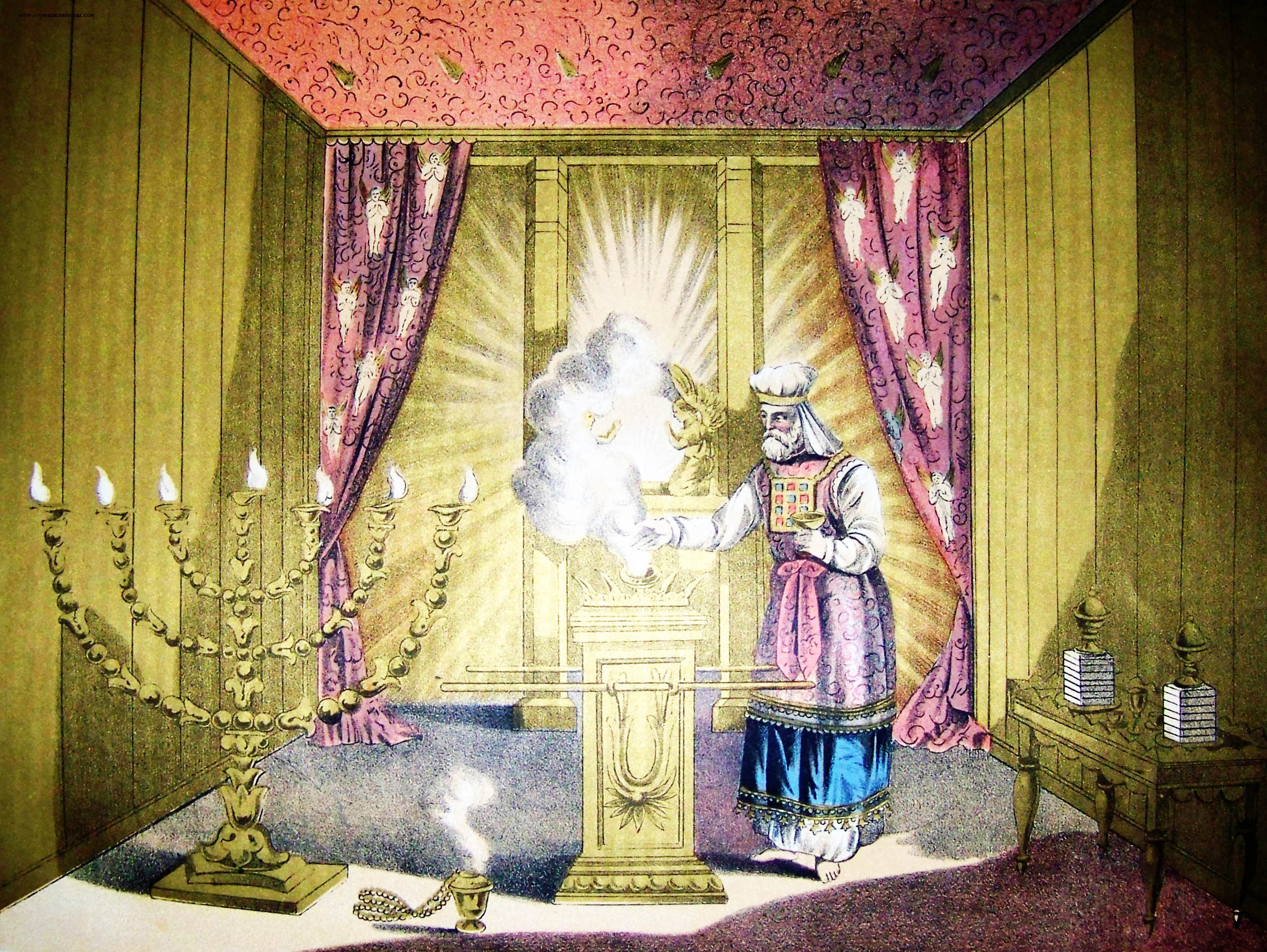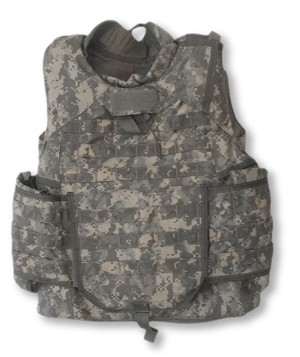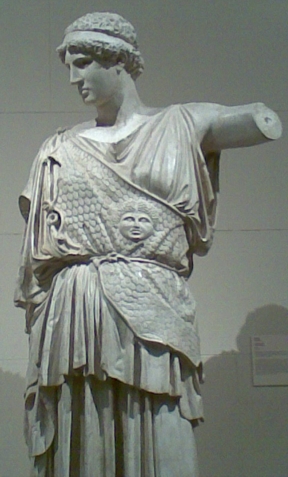|
Breastplate
A breastplate or chestplate is a device worn over the torso to protect it from injury, as an item of religious significance, or as an item of status. A breastplate is sometimes worn by mythological beings as a distinctive item of clothing. It is also a term for a piece of clothing used by drag queens and cross-dressing performers, which mimics a woman's cleavage or breasts. European In medieval weaponry, the breastplate is the front portion of plate armour covering the torso. It has been a military mainstay since ancient times and was usually made of leather, bronze or iron in antiquity. By around 1000 AD, solid plates had fallen out of use in Europe and knights of the period were wearing mail in the form of a hauberk over a padded tunic. Plates protecting the torso reappeared in the 1220s as plates directly attached to a knightly garment known as the surcoat. Around 1250 this developed into the coat of plates which continued to be in use for about a century. True breastplate ... [...More Info...] [...Related Items...] OR: [Wikipedia] [Google] [Baidu] |
Faulds (armour)
Faulds are pieces of plate armour worn below a breastplate to protect the waist and hips, which began to appear in Western Europe from about 1370. They consist of overlapping horizontal lames of metal, articulated for flexibility, that form an apron-like skirt in front. When worn with a cuirass, faulds are often paired with a similar defense for the rump called a culet, so that the faulds and culet form a skirt that surrounds the hips in front and back; the culet is often made of fewer lames than the fauld, especially on armor for a horseman. The faulds can either be riveted to the lower edge of the breastplate or made as a separate piece that the breastplate snugly overlaps. Although faulds varied in length, most faulds for field use ended above the knees. A pair of tassets Tassets are a piece of plate armour designed to protect the upper thighs. They take the form of separate plates hanging from the breastplate or faulds. They may be made from a single piece or segmented. ... [...More Info...] [...Related Items...] OR: [Wikipedia] [Google] [Baidu] |
Coat Of Plates
A coat of plates is a form of segmented torso armour consisting of overlapping metal plates riveted inside a cloth or leather garment. The coat of plates is considered part of the era of transitional armour and was normally worn as part of a full knightly harness. The coat saw its introduction in Europe among the warring elite in the 1180s or 1220s and was well established by the 1250s. It was in very common usage by the 1290s. By the 1350s it was universal among infantry militias as well. After about 1340, the plates covering the chest were combined to form an early breastplate, replacing the coat of plates. After 1370, the breastplate covered the entire torso. Different forms of the coat of plates, known as the brigandine and jack of plates, remained in use until the late 16th century. Construction The plates number anywhere from eight or ten to the hundreds depending on their size. The plates overlap, usually enough to guarantee full coverage even when moving around and fi ... [...More Info...] [...Related Items...] OR: [Wikipedia] [Google] [Baidu] |
Jewish High Priest
High Priest ( he, כהן גדול, translit=Kohen Gadol or ; ) was the title of the chief religious official of Judaism from the early post-Exilic times until the destruction of the Second Temple in Jerusalem by the Romans in 70 CE. Previously, in the Israelite religion, including during the time of the kingdoms of Israel and Judah, other terms were used to designate the leading priests; however, as long as a king was in place, the supreme ecclesiastical authority lay with him. The official introduction of the term "high priest" went hand-in-hand with a greatly enhanced ritual and political significance bestowed upon the chief priest of the Israelites in the post-Exilic period, especially from 411 BCE onward due to the religious transformations brought about during the time of the Babylonian captivity and due to the lack of a Jewish king and kingdom. The high priests belonged to the Jewish priestly families that trace their paternal line back to Aaron—the first high priest ... [...More Info...] [...Related Items...] OR: [Wikipedia] [Google] [Baidu] |
Plate Armour
Plate armour is a historical type of personal body armour made from bronze, iron, or steel plates, culminating in the iconic suit of armour entirely encasing the wearer. Full plate steel armour developed in Europe during the Late Middle Ages, especially in the context of the Hundred Years' War, from the coat of plates worn over mail suits during the 14th century. In Europe, plate armour reached its peak in the late 15th and early 16th centuries. The full suit of armour, also referred to as a panoply, is thus a feature of the very end of the Middle Ages and the Renaissance period. Its popular association with the " medieval knight” is due to the specialised jousting armour which developed in the 16th century. Full suits of Gothic plate armour were worn on the battlefields of the Burgundian and Italian Wars. The most heavily armoured troops of the period were heavy cavalry, such as the gendarmes and early cuirassiers, but the infantry troops of the Swiss mercenaries a ... [...More Info...] [...Related Items...] OR: [Wikipedia] [Google] [Baidu] |
Ballistic Vest
A bulletproof vest, also known as a ballistic vest or a bullet-resistant vest, is an item of body armor that helps absorb the impact and reduce or stop penetration to the torso from firearm-fired projectiles and fragmentation from explosions. The vest may come in a soft form, as worn by many police officers, prison guards, security guards, and some private citizens, used to protect against stabbing attacks or light projectiles, using metallic or para-aramid components. Soldiers, police tactical units, marines, and special operations forces wear hard armors, either in conjunction with soft armor or alone, to protect against rifle ammunition or fragmentation. History Early modern era In 1538, Francesco Maria della Rovere commissioned Filippo Negroli to create a bulletproof vest. In 1561, Maximilian II, Holy Roman Emperor is recorded as testing his armor against gun-fire. Similarly, in 1590 Sir Henry Lee expected his Greenwich armor to be "pistol proof". Its actual effectiveness ... [...More Info...] [...Related Items...] OR: [Wikipedia] [Google] [Baidu] |
Aegis
The aegis ( ; grc, αἰγίς ''aigís''), as stated in the ''Iliad'', is a device carried by Athena and Zeus, variously interpreted as an animal skin or a shield and sometimes featuring the head of a Gorgon. There may be a connection with a deity named Aex or Aix, a daughter of Helios and a nurse of Zeus or alternatively a mistress of Zeus (Gaius Julius Hyginus, Hyginus, ''Astronomica'' 2. 13). The modern concept of doing something "under someone's ''aegis'' means doing something under the protection of a powerful, knowledgeable, or benevolent source. The word ''aegis'' is identified with protection by a strong force with its roots in Greek mythology and adopted by the Roman mythology, Romans; there are Comparative_mythology, parallels in Norse mythology and in Egyptian mythology as well, where the Greek word ''aegis'' is applied by extension. Etymology The Greek language, Greek ''aigis'', has many meanings including: # "violent windstorm", from the verb ''aïssō'' (word ... [...More Info...] [...Related Items...] OR: [Wikipedia] [Google] [Baidu] |
Karambalangan
Karambalangan is a type of personal armor from Java. It is a metal coating worn in front of the chest or breastplate. History Karambalangan was recorded in the ''Kidung'' ''Panji Wijayakrama-Rangga Lawe'' (written as early as 1334 AD), which mentioned that Ranggalawe wore ''karambalangan manik'' (jeweled karambalangan) when he rebelled against Majapahit (1295 AD).Berg, C.C. (1930). Rangga Lawe: Middeljavaansche Historische Roman: Critisch uitgegeven'. Batavia: Kon. Bataviaasch Genootschap van Kunsten en Wetenschappen (''Bibliotheca Javanica'', 1). Emperor Raden Wijaya in that kidung was recorded using golden ''karambalangan manik''. In the ''Kidung Sundayana'', it is written that Gajah Mada before the Bubat tragedy wore a karambalangan (a metal plate on the front of the chest—breastplate) decorated with gold emboss, armed with a gold-plated spear, and a shield decorated with diamonds. See also * Baju rantai * Baju lamina * Baju empurau * Baru Oroba * Baru lema'a * ... [...More Info...] [...Related Items...] OR: [Wikipedia] [Google] [Baidu] |
Tasset
Tassets are a piece of plate armour designed to protect the upper thighs. They take the form of separate plates hanging from the breastplate or faulds. They may be made from a single piece or segmented. The segmented style of tassets connected by sliding rivets produced during the 16th century is also known as ''almain rivets''. From the 16th century onward, the tassets were sometimes integrated with the cuisses to create fully articulated leg defenses that continued from the lower edge of the breastplate down to the poleyn The poleyn or genouillere was a component of Medieval and Renaissance armor that protected the knee. During the transition from mail armor to plate armor, this was among the earliest plate components to develop. They first appeared around 1230 .... External links *Cleveland Museum of Artglossary of arms and armor Western plate armour {{medieval-armour-stub ... [...More Info...] [...Related Items...] OR: [Wikipedia] [Google] [Baidu] |
Athena
Athena or Athene, often given the epithet Pallas, is an ancient Greek goddess associated with wisdom, warfare, and handicraft who was later syncretized with the Roman goddess Minerva. Athena was regarded as the patron and protectress of various cities across Greece, particularly the city of Athens, from which she most likely received her name. The Parthenon on the Acropolis of Athens is dedicated to her. Her major symbols include owls, olive trees, snakes, and the Gorgoneion. In art, she is generally depicted wearing a helmet and holding a spear. From her origin as an Aegean palace goddess, Athena was closely associated with the city. She was known as ''Polias'' and ''Poliouchos'' (both derived from '' polis'', meaning "city-state"), and her temples were usually located atop the fortified acropolis in the central part of the city. The Parthenon on the Athenian Acropolis is dedicated to her, along with numerous other temples and monuments. As the patron of craft an ... [...More Info...] [...Related Items...] OR: [Wikipedia] [Google] [Baidu] |
Majapahit Empire
Majapahit ( jv, ꦩꦗꦥꦲꦶꦠ꧀; ), also known as Wilwatikta ( jv, ꦮꦶꦭ꧀ꦮꦠꦶꦏ꧀ꦠ; ), was a Javanese Hindu-Buddhist thalassocratic empire in Southeast Asia that was based on the island of Java (in modern-day Indonesia). It existed from 1293 to circa 1527 and reached its peak of glory during the era of Hayam Wuruk, whose reign from 1350 to 1389 was marked by conquests that extended throughout Southeast Asia. His achievement is also credited to his prime minister, Gajah Mada. According to the () written in 1365, Majapahit was an empire of 98 tributaries, stretching from Sumatra to New Guinea; consisting of present-day Indonesia, Singapore, Malaysia, Brunei, southern Thailand, Timor Leste, southwestern Philippines (in particular the Sulu Archipelago) although the scope of Majapahit sphere of influence is still the subject of debate among historians. The nature of Majapahit relations and influences upon its overseas vassals, and also its status as an ... [...More Info...] [...Related Items...] OR: [Wikipedia] [Google] [Baidu] |
Carabiniers-à-Cheval
The Carabiniers-à-Cheval ( French for Horse Carabiniers or Mounted Carabiniers) were mounted troops in the service of France. Their origins date back to the mid-16th century, when they were created as elite elements of the French light cavalry, armed with carbines but then gradually evolved towards semi-independent status during the 18th century. They only became independent units as late as 1788, when a two-regiment heavy cavalry corps was created. From the French Revolutionary Wars onwards, they were the senior heavy cavalry regiments in the French army, rose to prominence during the Napoleonic Wars and were disbanded in 1871, after the fall of the Second French Empire. Ancien Régime The French carabiniers are first mentioned at the battle of Neerwinden in 1693 commanded by Prince de Conti. Although their original role was that of a mounted police similar to the Gendarmes, as combat troops they were first took the form of separate companies within each cavalry regiments on 29 ... [...More Info...] [...Related Items...] OR: [Wikipedia] [Google] [Baidu] |
Medusa
In Greek mythology, Medusa (; Ancient Greek: Μέδουσα "guardian, protectress"), also called Gorgo, was one of the three monstrous Gorgons, generally described as winged human females with living venomous snakes in place of hair. Those who gazed into her eyes would turn to stone. Most sources describe her as the daughter of Phorcys and Ceto, although the author Hyginus makes her the daughter of Gorgon and Ceto. Medusa was beheaded by the Greek hero Perseus, who then used her head, which retained its ability to turn onlookers to stone, as a weapon until he gave it to the goddess Athena to place on her shield. In classical antiquity, the image of the head of Medusa appeared in the evil-averting device known as the '' Gorgoneion''. According to Hesiod and Aeschylus, she lived and died on Sarpedon, somewhere near Cisthene. The 2nd-century BC novelist Dionysios Skytobrachion puts her somewhere in Libya, where Herodotus had said the Berbers originated her myth as p ... [...More Info...] [...Related Items...] OR: [Wikipedia] [Google] [Baidu] |






_last_quarter_of_the_10th–first_half_of_the_11th_century.jpg)


.jpg)

